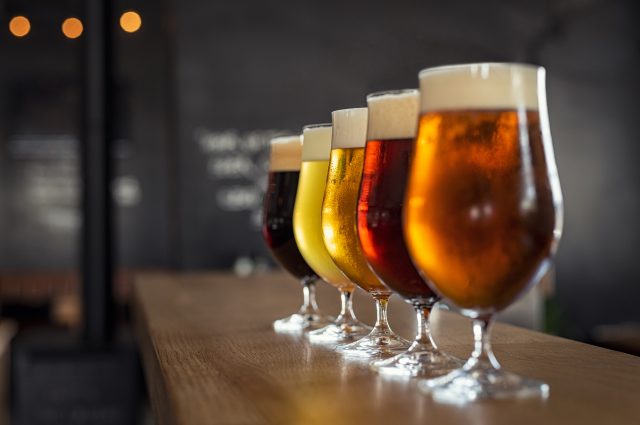This website uses cookies so that we can provide you with the best user experience possible. Cookie information is stored in your browser and performs functions such as recognising you when you return to our website and helping our team to understand which sections of the website you find most interesting and useful.
Reasons why AI will take over beer recipe creation
Scientists have found a way to train AI to identify beer flavour compounds to make predictions on what consumers will enjoy drinking the most.

The research, which involved chemical and sensory analyses of 250 different beers, has been used to “train machine learning models that allow predicting flavour and consumer appreciation”.
Scientists stated that “for each beer, we measure over 200 chemical properties, perform quantitative descriptive sensory analysis with a trained tasting panel and map data from over 180,000 consumer reviews to train 10 different machine learning models”.
According to the study, “predicting and understanding food perception and appreciation is one of the major challenges in food science” but accurate modelling of flavour and appreciation could “yield important opportunities for both producers and consumers, including quality control, product fingerprinting, counterfeit detection, spoilage detection, and the development of new products and product combinations”.
The research outlined that “despite the myriad of applications”, predicting “flavour and appreciation from chemical properties remains a largely elusive goal in sensory science, especially for complex food and beverages”. As such, when it comes to recipe creation, plumping for one trend over another is no simple feat because “a key obstacle is the immense number of flavour-active chemicals” all clamouring for attention. Plus, drilling down to what will be most popular is difficult in recipe creation because “flavour compounds can vary widely in chemical structure and concentration, making them technically challenging and labour-intensive to quantify, even in the face of innovations in metabolomics, such as non-targeted metabolic fingerprinting.”
To explain the strides that the more informed machine-learning route had taken, scientists also highlighted “flavour perception is highly complex, resulting from hundreds of different molecules interacting at the physiochemical and sensorial level” which means “sensory perception is often non-linear, characterised by complex and concentration-dependent synergistic and antagonistic effects that are further convoluted by the genetics, environment, culture and psychology of consumers”.
This means that “perceived flavour is therefore difficult to measure” and so “trained tasting panels are considered the prime source of quality sensory data, but require meticulous training, are low throughput and high cost”. It was also noted that even though “public databases offer the advantage of amassing large amounts of data” it can also “suffer from biases, including a bias in the volunteers that contribute to the database, as well as confounding factors such as price, cult status and psychological conformity towards previous ratings of the product”.
In the study, the researchers combined “extensive chemical analyses and sensory data of a set of different commercial beers with machine learning approaches to develop models that predict taste, smell, mouthfeel and appreciation from compound concentrations”.
A plus-point was that the study found that “beer is particularly suited to model the relationship between chemistry, flavour and appreciation” because “beer is a complex product, consisting of thousands of flavour compounds” due to the “chemical diversity [that] arises from the raw materials (malt, yeast, hops, water and spices) and biochemical conversions during the brewing process (kilning, mashing, boiling, fermentation, maturation and ageing)”.
These advantages, along with the fact that “beer consumers embrace online review platforms, such as RateBeer and BeerAdvocate…the beer community provides massive data sets of beer flavour and appreciation scores, creating extraordinarily large sensory databases to complement the analyses” of a professional sensory panel.
The data has enabled the scientists “to train a suite of machine learning models to predict flavour and appreciation from a beer’s chemical profile” and a “dissection of the best-performing models”. Additionally, it has allowed them “to pinpoint specific compounds as potential drivers of beer flavour and appreciation”. Follow-up experiments have already confirmed the importance of these compounds and “significantly improve the flavour and appreciation of selected commercial beers”.
The scientists concluded that “despite the inherent limitations, dissection of our models enabled us to pinpoint specific molecules as potential drivers of beer aroma and consumer appreciation, including compounds that were unexpected and would not have been identified using standard approaches. Important drivers of beer appreciation uncovered by our models include protein levels, ethyl acetate, ethyl phenyl acetate and lactic acid”. The team noted that “currently, many brewers already use lactic acid to acidify their brewing water and ensure optimal pH for enzymatic activity during the mashing process” but also pointed out that “results suggest that adding lactic acid can also improve beer appreciation, although its individual effect remains to be tested”.
The researchers added that “interestingly, ethanol appears to be unnecessary to improve beer appreciation, both for blond beer and alcohol-free beer. Given the growing consumer interest in alcohol-free beer…it is relevant for brewers to know what compounds can further increase consumer appreciation of these beers. Hence, our model may readily provide avenues to further improve the flavour and consumer appreciation of both alcoholic and non-alcoholic beers, which is generally considered one of the key challenges for future beer production”.

